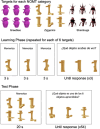Measuring visual ability in linguistically diverse populations
- PMID: 39738819
- PMCID: PMC11685244
- DOI: 10.3758/s13428-024-02579-x
Measuring visual ability in linguistically diverse populations
Abstract
Measurement of object recognition (OR) ability could predict learning and success in real-world settings, and there is hope that it may reduce bias often observed in cognitive tests. Although the measurement of visual OR is not expected to be influenced by the language of participants or the language of instructions, these assumptions remain largely untested. Here, we address the challenges of measuring OR abilities across linguistically diverse populations. In Study 1, we find that English-Spanish bilinguals, when randomly assigned to the English or Spanish version of the novel object memory test (NOMT), exhibit a highly similar overall performance. Study 2 extends this by assessing psychometric equivalence using an approach grounded in item response theory (IRT). We examined whether groups fluent in English or Spanish differed in (a) latent OR ability as assessed by a three-parameter logistic IRT model, and (2) the mapping of observed item responses on the latent OR construct, as assessed by differential item functioning (DIF) analyses. Spanish speakers performed better than English speakers, a difference we suggest is due to motivational differences between groups of vastly different size on the Prolific platform. That we found no substantial DIF between the groups tested in English or Spanish on the NOMT indicates measurement invariance. The feasibility of increasing diversity by combining groups tested in different languages remains unexplored. Adopting this approach could enable visual scientists to enhance diversity, equity, and inclusion in their research, and potentially in the broader application of their work in society.
Keywords: English; High-level vision; Individual differences; Measurement; Object recognition; Spanish.
© 2024. The Author(s).
Conflict of interest statement
Declarations. Open practices statement: This study was not preregistered. The materials and datasets generated during and analyzed during the current study are available in the figshare repository: https://doi.org/10.6084/m9.figshare.24395098.v2 . Ethics approval: Vanderbilt IRB protocol 050082, “Comparing Different Types of Perceptual Expertise.” Consent to participate: All participants provided written informed consent. Consent for publication: N/A. Conflicts of interest/Competing interests: The authors have no conflict of interest to declare.
Figures




Similar articles
-
Research applications for an Object and Action Naming Battery to assess naming skills in adult Spanish-English bilingual speakers.Behav Res Methods. 2014 Jun;46(2):456-71. doi: 10.3758/s13428-013-0381-7. Behav Res Methods. 2014. PMID: 24002987 Clinical Trial.
-
Word-context associations in episodic memory are learned at the conceptual level: Word frequency, bilingual proficiency, and bilingual status effects on source memory.J Exp Psychol Learn Mem Cogn. 2019 Oct;45(10):1852-1871. doi: 10.1037/xlm0000678. Epub 2018 Dec 20. J Exp Psychol Learn Mem Cogn. 2019. PMID: 30570325 Free PMC article.
-
Item-level psychometrics and predictors of performance for Spanish/English bilingual speakers on an object and action naming battery.J Speech Lang Hear Res. 2012 Apr;55(2):359-81. doi: 10.1044/1092-4388(2011/10-0307). Epub 2012 Jan 3. J Speech Lang Hear Res. 2012. PMID: 22215032
-
Identification of differential item functioning using item response theory and the likelihood-based model comparison approach. Application to the Mini-Mental State Examination.Med Care. 2006 Nov;44(11 Suppl 3):S134-42. doi: 10.1097/01.mlr.0000245251.83359.8c. Med Care. 2006. PMID: 17060820 Review.
-
A cultural neuropsychological approach to harmonization of cognitive data across culturally and linguistically diverse older adult populations.Neuropsychology. 2023 Mar;37(3):247-257. doi: 10.1037/neu0000816. Epub 2022 Apr 28. Neuropsychology. 2023. PMID: 35482625 Free PMC article. Review.
Cited by
-
An introduction to the Item Response Warehouse (IRW): A resource for enhancing data usage in psychometrics.Behav Res Methods. 2025 Sep 5;57(10):276. doi: 10.3758/s13428-025-02796-y. Behav Res Methods. 2025. PMID: 40913152 Free PMC article.
References
-
- Akaike, H. (1973). Information theory and an extension of the maximum likelihood principle. Proc. 2nd International Symposium on Information Theory, 1973, 267–281.
-
- Akour, M., & Al-Omari, H. (2013). Empirical Investigation of the Stability of IRT Item-Parameters Estimation. International Online Journal of Educational Sciences, 5(2). https://www.acarindex.com/dosyalar/makale/acarindex-1423904223.pdf. Accessed 8 Nov 2024.
-
- Anderson, D., Kahn, J. D., & Tindal, G. (2017). Exploring the robustness of a unidimensional item response theory model with empirically multidimensional data. Applied Measurement in Education,30(3), 163–177. 10.1080/08957347.2017.1316277
-
- Anderson, G., Linton, O., & Whang, Y.-J. (2012). Nonparametric estimation and inference about the overlap of two distributions. Journal of Econometrics,171(1), 1–23.
-
- Baker, F. B. (2001). The basics of item response theory. ERIC. https://eric.ed.gov/?id=ED458219 - PMC - PubMed
Publication types
MeSH terms
Grants and funding
LinkOut - more resources
Full Text Sources
Medical

